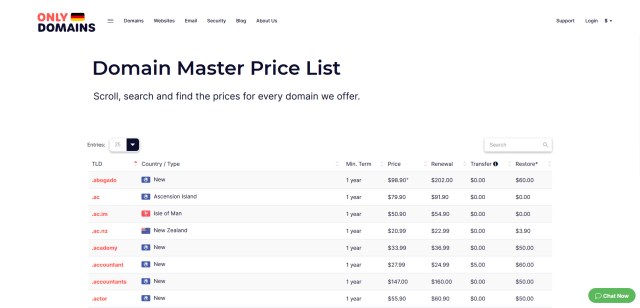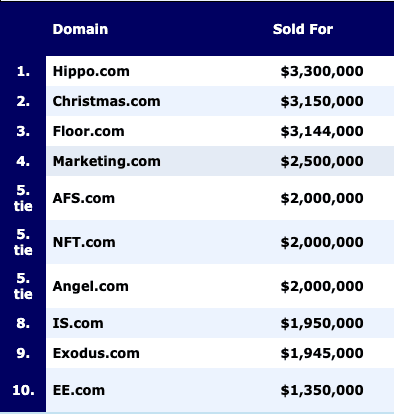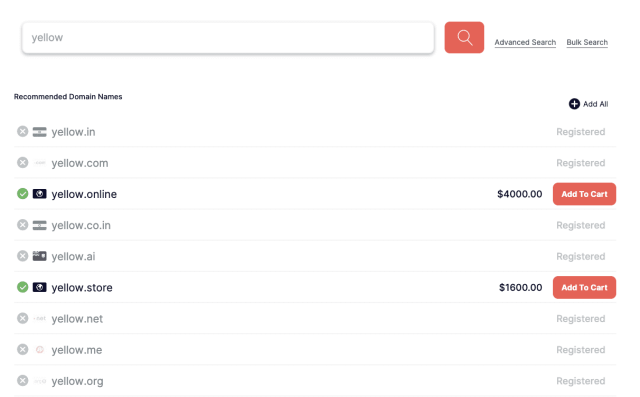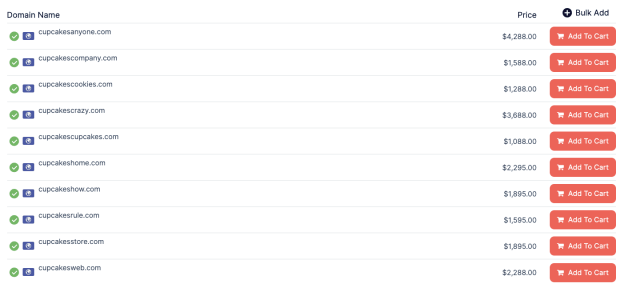How Much Does a Domain Name Cost, Really?
In today’s internet era, you can’t think about starting a business without purchasing a domain name. And sometimes, finding the right domain name turns a fledgling idea into a proper startup.
For many of us, this begs the question of what exactly is the cost of a domain name? The answer isn’t straightforward and can vary depending on the domain you have in mind. But with a bit of creativity and common sense, you too can acquire a domain name that will boost your brand.
In this article, we will cover:
Why do You Need a Domain Name?
Choosing a Suitable Domain Name
4 Factors Impacting the Cost of a Domain Name
Other Domain Name Fees to Look Out For
Gauging the Value of a Premium Domain Name
Recap: How Much Does a Domain Cost, Really?
What is a Domain Name?
A domain name is an address a user types in the browser to reach your website. It’s also commonly referred to as a web address, website address, or URL.
Like ours is onlydomains.com, Google’s is google.com, and so on.
Why Do You Need a Domain Name?
A few decades ago, every business needed a brick-and-mortar store or an office to function. The physical location allowed potential customers to interact with the business and purchase products and services.
Today, instead of commercial real estate, businesses from all over the world are vying for virtual real estate on the internet. And a domain name is that digital space where consumers can find your brand, engage with it, and hit the “buy now” button.
Just like physical locations, website owners must pick a strategic address for their businesses to reside. It can generate traffic and boost credibility.

Choosing a Suitable Domain Name
When it comes to choosing a suitable domain name, you should consider 2 main factors:
1. Availability
2. Your target audience
Domain Name Availability
Given the popularity of this thing called the ‘internet’, chances are someone else has already thought of and purchased the domain you have in mind, especially in .COM.
A domain may be unavailable because another business is using it or a domain investor has bought it and plans to sell it to someone at a good price (very similar to real estate).

Picking the Right TLD
Top Level Domains (TLDs) are the letters you see furthest to the right of a web address. They are also known as domain extensions or domain endings i.e. your domain ends in it eg: onlydomains.com ends in .COM, seths.blog ends in .BLOG.
There are different categories of domain endings you can choose from:
- Country specific domains: These represent countries or territories like .CO.NZ, .US, .UK .COM.AU or .AE. They are also known as country code top-level domains (ccTLDs) and pretty much every country out there has one.
Many ccTLDs are repurposed as global extensions eg: .IO (British Indian Territories) and .AI (Anguilla), have become popular domain names for tech companies and stand for Input/Output and Artificial Intelligence respectively. - Generic domain endings: Chances are you’ve heard and interacted with a lot of websites that use these domain endings
- .COM for businesses and everything under the sun
- .NET for organizations using network technologies
- .ORG for non-profits and organisations
- .EDU for educational institutions
- .GOV for government agencies
- New Domain endings can indicate your association to a specific industry or vertical. Here are a few self explanatory examples:
- .BLOG
- .DESIGN
- .STORE
- .TECH
- .ART
- .ONLINE, .XYZ are more generic and compete with .COM, .NET
The categories are in no way watertight, you can be as creative as you like.
Not all TLDs are not created equal. .COM is still leading the way when it comes to trust, but there is a sea of options with ample of hidden gems available.
If you’re a business working in ecommerce, .COM or .BIZ would be a good TLD. But what if your business sold fishing equipment? Fishing.net or yourbrand.fishing has a nice ring to it.
You may also like: Undecided between .COM and a ccTLD
Overview of Domain Name Costs
Just like your Netflix or Amazon Prime subscription, domains are also purchased on an annual subscription basis i.e. need to be renewed every year.
You also have the option to register a domain for up to 10 years in a single go, if you prefer that.
Per-year registration costs will vary depending on the domain you acquire. A .AI domain is more expensive than a .COM, .NET or .ORG domain. The registry (i.e. the upstream provider) sets the pricing for each domain ending.
4 Factors Impacting the Cost of a Domain Name
When buying a domain name, there are normally four types of fees that can make up the total cost. We recommend checking these before registering a domain so there aren’t any surprises when your domain comes up for renewal or if you wish to transfer it elsewhere.
1. Registration Fee – New Domain Name Cost
The cost of purchasing an available domain name is pretty straightforward. Domain name prices vary depending on the registrar and domain ending you choose. At OnlyDomains, you can expect to pay anywhere between $0.99 to $14.99 per year for most domain names.
Some TLDs like .AI can cost more per year ($100+) and need to be registered for 2 years at a minimum.
With so many domain options, individuals and small businesses should be able to find something that won’t break the bank.
2. Renewal Fee
When you first purchase a domain name, you’ll pay a price for the first year or the duration you register it for. You will need to pay the annual renewal fee when the domain is up for renewal. The renewal fee is usually the same as the registration fee unless the 1st year was being offered at a promotional price.
Most domain providers will have this information on their website. You can view the registration, renewal, transfer prices at OnlyDomains here.
You register a .COM domain at OnlyDomains for 1-10 years upfront. You will pay the same annual price per year each time you renew. In this case, that would be 9.99 USD per year.
3. Transfer Fee – Moving to Another Domain Provider
You have the option to move a domain from one registrar to another. Some transfers like .COM.AU are free, for others like .COM, .ORG you pay for the additional year added to your domain name at the time of transfer.
Managing domains at different registrars can be an exhausting exercise. If you already own domains, it would be wise to transfer all your domains to the same place. We have a neat domain transfer tool to quickly transfer up to 1,000 domains at a time.
4. Whois Privacy
When you register a domain name, your name and contact information is displayed in the whois database, which is public. A whois search can help anyone find the ownership details of a domain name i.e. anyone else can find your details too.
But all is not lost, domain owners can protect their privacy by enabling domain privacy i.e. masking your personal details.
OnlyDomains domain privacy for every domain you register, free of charge. This service is available for all domain endings that allow Whois privacy.
Other Domain Name Fees to Look Out For
Always do your due diligence before signing up with a domain provider. Otherwise, you may find yourself surprised by additional and unexpected fees.
Hidden Fees
With the wrong registrar, registering a domain can come with hidden fees attached. The additional costs are camouflaged in the forests of the terms of service. Most of us don’t have the desire or time to read through a legal document. But you can look up reviews on any registrar to look for user complaints about hidden fees.
One-Time Discounts
Some companies will offer a considerable discount for a new domain. However, bear in mind that each renewal will be at a much higher price. A one-time discount, therefore, may not be cost-effective in the long term. You can clearly compare registration, renewal, and transfer prices at OnlyDomains on our pricing page.

Premium Domains
Premium Domains are domains that are available at a premium i.e., not the standard price. Domains that carry a premium price tag are often 1-word dictionary word domains like hotels, cat, shoes, technology, or 1-3 character domain names. A general rule of thumb is the shorter the domain, the more valuable it is – you can read more on this topic here.
There are 2 types of Premium Domains:
- One-time Premium Domains: These domains are listed for sale by existing domain owners and are available at a one-time premium price.
Here is an example for the term ‘cupcakes’ from the OnlyDomains Marketplace
- You can see the registration price is higher than the standard price. Once you’ve secured a name from this list it renews at the standard price associated with the domain ending eg: cupcakescompany.com would renew at 9.99 USD at OnlyDomains
Premium domains can be purchased through a host of different channels. The sale price can range widely in costs from hundreds to a few thousand dollars to tens of millions. Here are are the top sales for the year:

- Premiums for their Life – Renew at a Premium Price
Several new domain endings like .ONLINE, .STORE, .TECH. DESIGN offer premium domains at a lower price vs. traditional domain endings like .COM, .ORG etc.
The key difference here is that these domains also renew at a premium price. Let’s say you were looking to start a company called Yellow. A quick domain search will show this term is taken in most domain endings.
It appears available in .ONLINE, .STORE at a premium price. These premium domains will renew at a premium price too.

Gauging the Value of a Premium Domain Name
Most premium domain names in popular domain endings like .COM, .NET, .ORG have been snatched up since the1990s. These names have either been sold off to big entities, parked, or redirected to paying customer sites. However, there are still many that are being held by domain investors patiently waiting for the right buyer that can afford these domains.
“The cost of a premium domain name can be anywhere from a few thousand dollars to tens of millions. Why? Because they not only increase the value of a brand but also improve consumer trust. “
– Forbes
At the end of the day, a premium domain name is worth whatever someone is willing to pay for it. We like to think the value of a premium comes down to what it can do for you, your business.
1. Branding
You may need a domain name to align with your brand. Having a company and domain name mismatch can hurt your reputation and brand image. For certain organizations, this isn’t negotiable.
In 2004 the world was introduced to TheFacebook. Soon after, the prefix ‘the’ was dropped. Zuckerberg and co. had to shell out $200,000 for www.facebook.com in 2005.
2. Credibility
Certain domain names can add an aura of instant credibility to the company and its website. For savvy businesses like tech startups looking for more investment, this can pay off huge dividends. Take the domain name robotics.ai, it perfectly conveys what the business is about.
Another favorite example of ours is copy.ai
3. Traffic Generation
Many premium domains will come with free traffic simply from type-in traffic i.e. users typing the word in their browser or google. These would be domains like cars.com or the aforementioned marketing.com. Other websites may have been built on these premium domains in the past, which means they come with inbound traffic from links all over the web. This type of ‘free’ traffic may come at a cost so best to do an SEO audit before buying and moving your brand to a pre-owned premium domain.
4. Short and Memorable
Premium domain names are usually short and memorable. This means they’re easy for people to remember. Google and Bing weren’t given funny names for no reason. If you’re hoping to get a short domain name, expect to reach deep into your wallet or get creative and make up words like Google, Bing, Flickr, Twitter, Tumblr.
How to Register a Domain Name
Registering a domain name at OnlyDomains is easy:
- Enter your desired term or domain name into our domain registration search tool.
- Search results will show if the exact domain you searched for is availabe. But don’t worry, we also have a long list of suitable alternatives. You might even see something you like better for a lower price.
- When you’re done choosing domain names, click “Add to Cart”, and select “Checkout.”
- You’ll then need to create an OnlyDomains account to manage this domain name.
- From the checkout cart, you can see all of the information you need. Domain privacy protection can be turned on or off (for TLDs that allow it). And you can select your registration fee period. You can also add WordPress hosting or a website builder if you already know how you want to build your website.
- The total will be listed at the bottom. Once you’re satisfied, click on “continue”.
- Enter your payment details and click “Pay Now.”
That’s it. You now own the domain of your dreams. Now it’s time to build that website and start pulling in traffic.
Recap: How Much Does a Domain Cost, Really?
In most cases, registering a domain should be a sub $15 affair. And for the happy few who are compelled to and can afford a premium domain name, the sky is truly the limit.
You may be a freelancer, a travel agency owner, an eCommerce business, or run a non-profit organization. But whatever you pay for a domain name, you’re likely to make a great return on investment in the form of traffic, sales, and lifelong branding.
You May Also Like


